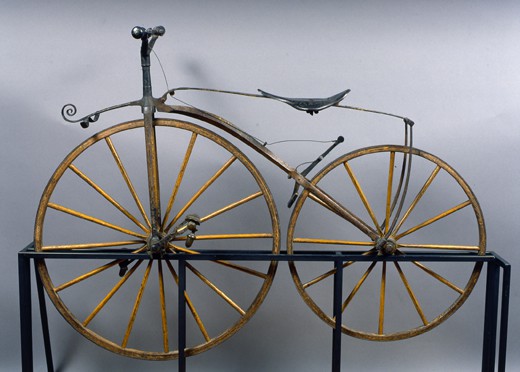This velocipede, which may have once belonged to Napoleon III's son, Napoleon-Eugene the Prince Imperial, was given to Alberto di Roccagiovine (son of Julie Bonaparte, who was the daughter of Charles-Lucien Bonaparte, who in turn was the son of Lucien Bonaparte, brother of Napoleon). Since the maker's stamp on the velocipede mentions the years 1869, the period when the Michaux company had joined up with the three Olivier brothers to form the Compagnie Parisienne, Alberto Roccagiovine could have received the machine in November or December 1876, when the young Prince Imperial, accompanied by his mother, paid a formal visit to his extended family in Rome.
Pierre Michaux and his sons were early pioneers in the production of what would become known as the bicycle. The first mention of what he called his “vélocipède” occurs in 1864. Michaux's innovation was the attachment of pedals (to which weights were attached so as to keep them horizontal) to the axle of the front wheel of old Draisines – earlier machines, also called velocipedes, were propelled forward by the rider pushing off the ground with his feet (effectively push bikes). In Michaux's contraption, the front wheel thus became the driving force. A breaking mechanism was also added that could be activated from the handlebars. The velocipede's weight was made lighter by replacing the cast-iron frame with one made of wrought iron (although it was still pretty heavy at about 30 kg!) and some models came with a saddle that could be raised or lowered. These improvements were applied to the 1867 series, the same year in which the Maison Michaux was founded. One year later, Michaux filed a patent for his “Perfectionnement dans la construction des vélocipèdes” (French patent n° 80 637, submitted 24 April 1868).
The young Prince Imperial was a great enthusiast of this new technology and Parisians came to know him as the “little one who pedaled everywhere”. He attended the first official velocipede track race on 31 May, 1868, which took place in the Parc de Saint-Cloud; the winner of this inaugural competition received a gold medal featuring an image of the Emperor. The prince's enthusiasm for such pedal-driven machines also gave birth to a nickname that was given to him by caricaturists after the fall of the empire: Napoléon Eugène-Louis-Jean-Joseph Vélocipède IV!
The Fondation Napoléon would like to thank Giulia Gorgone, director of the Museo Napoleonico, for allowing the image and article, originally in Italian and published in the book Museo Napoleonico: Guida (Milan: Mondadori Electa S.P.A., 2008, p. 84), to be reproduced on napoleon.org.
Bibliography
– Claude Reynaud, Le vélocipède illustré…et déjà la bicyclette, Domazan: Musée du Vélo et de la Moto.- 2008.- 2 vol. (400 p.)
– Keizo Kobayashi, Histoire du vélocipède de Drais à Michaux, 1817-1870: mythes et réalités, K. Kobayashi ([Tokyo, Japan]), 1991, (406 p.)
Marco Fortini, with Peter Hicks and Claude Reynaud (tr. H.D.W.)
October 2009
The Prince Imperial’s velocipede
Artist(s) : Compagnie Parisienne (Ancienne Maison Michaux & C.ie)

- Date :
- 1869
- Technique :
- Wood, cast iron
- Dimensions :
- H = 115 cm, L = 150 cm
- Place held :
- Museo Napoleonico, Rome
- Photo credit :
- © Archivio fotografico del Museo Napolonico

